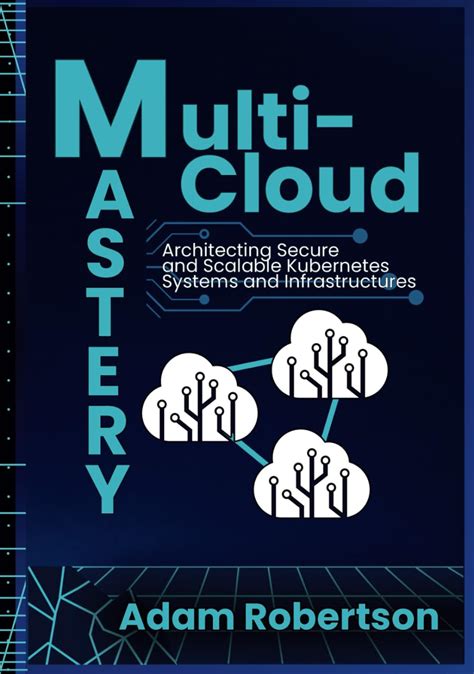Insights from Multi-Cloud Mastery: Architecting Secure and Scalable Kubernetes Systems and Infrastructures
While managing my own projects that rely on Kubernetes clusters, I often encountered challenges involving scalability, security, and cost optimisation across various cloud providers. These obstacles made me curious about how industry experts approach multi-cloud Kubernetes environments. That’s when I stumbled upon Multi-Cloud Mastery by Adam Robertson.
This book dives into the complexities of building and managing Kubernetes clusters across multiple cloud platforms. It offers practical advice for architects, platform engineers, and cloud enthusiasts seeking to harness the potential of multi-cloud strategies. I chose this book to gain deeper insights into a topic that lies at the heart of modern cloud computing balancing resilience, performance, and cost in a multi-cloud Kubernetes environment.

Summary
Part 1: Foundations
Chapter 1: Getting Started with Project Planning and Preparation
This chapter introduces multi-cloud Kubernetes strategies by explaining their importance in today’s tech landscape. It discusses containerisation, Kubernetes evolution, and the steps needed for successful project planning, such as defining objectives, selecting Kubernetes distributions, and assessing infrastructure.
Key Quote: “Diligent planning is the bedrock of resilient and scalable multi-cloud systems.” – Adam Robertson, p. 22
Chapter 2: Running Multi-Cloud Kubernetes
Here, the book highlights the pros and cons of managing Kubernetes clusters across cloud providers, emphasising operational consistency and detailing best practices for use cases like disaster recovery, high availability, and geographic optimisation.
Part 2: Deployment Scenarios
Chapter 3: Scenarios of Multi-Cloud Deployment
The book contrasts stateful and stateless applications, describing deployment patterns tailored to each type. Use cases like workload migration, disaster recovery, and hybrid cloud setups are also explored, offering insights into their benefits and challenges.
Chapter 4: Stateful Application Kubernetes Cluster Design
This chapter focuses on designing resilient clusters for stateful applications, detailing strategies for data persistence and availability across clouds, such as shared real-time data systems.
Chapter 5: Stateless Application Kubernetes Cluster Design
The book transitions to stateless applications, emphasising efficient deployment patterns and scaling strategies. Concepts like load balancing and NGINX server deployment are explored through hands-on examples.
Part 3: Advanced Operations
Chapter 6: Service Mesh: Operations
Service mesh frameworks like Istio and Envoy are discussed in-depth for improving inter-service communication and operational resilience. Topics include traffic control, resiliency strategies, and observability in service meshes.
Chapter 7: Service Mesh: Security
The focus shifts to enhancing security within service meshes, covering mutual TLS, access control, and network isolation. It provides a comprehensive view of threat modeling and best practices.
Chapter 8: GitOps Method of Workload Deployment
This chapter explores GitOps as a declarative approach for workload deployment, ensuring consistency through automated pipelines. Tools like ArgoCD are highlighted as enablers of seamless, reproducible deployments.
Chapter 9: GitOps Method of Policy Deployment
Building on the previous chapter, GitOps is applied to managing policies as code, streamlining governance, compliance, and security enforcement across Kubernetes clusters.
Part 4: Monitoring, Observability, and Security
Chapter 10: Proactive Monitoring of the Clusters
Proactive monitoring is explored as a means of ensuring cluster health, leveraging metrics, logs, and traces to anticipate and address potential issues before they impact operations.
Chapter 11: Enabling Comprehensive Observability
The book dives into observability's three pillars: metrics, logs, and traces. It introduces tools and techniques for gaining actionable insights into a multi-cloud Kubernetes environment.
Chapter 12: Securing Your Clusters
This chapter provides actionable advice for safeguarding Kubernetes clusters, covering authentication, network security, and intra-cluster communication. Tools like RBAC and encryption strategies are thoroughly examined.
Part 5: Case Studies
Chapter 13: Deploying Highly Available Applications on Multi-Cloud Kubernetes
The book concludes with a real-world case study, showcasing the deployment of highly available applications across multiple cloud Kubernetes clusters. Step-by-step instructions and best practices are included to tie together the concepts discussed throughout the book.
Key Takeaways
Key Takeaway 1: Planning is Everything
- Meticulous planning is emphasised as crucial for successful multi-cloud Kubernetes implementations. This includes defining objectives, selecting tools, and assessing infrastructure.
- Planning upfront prevents scope creep and ensures alignment with broader goals.
- Quote: “A multi-cloud strategy is not just about avoiding vendor lock-in it’s about leveraging the best tools from multiple providers to maximize your organization’s agility and resilience.” – Adam Robertson, p. 17
Key Takeaway 2: Service Mesh as a Backbone
- Service meshes like Istio enhance communication, security, and observability within multi-cloud environments.
- I see significant value in adopting service meshes for projects requiring robust inter-service communication.
- Quote: “Service meshes enable seamless inter-service communication while elevating security and observability.” – Adam Robertson, p. 96
Key Takeaway 3: GitOps is the Future
- GitOps offers a declarative approach to managing Kubernetes infrastructure and workloads, reducing configuration drift.
- Quote: “GitOps bridges the gap between code and infrastructure, enabling seamless deployments in multi-cloud environments.” – Adam Robertson, p. 120
Key Takeaway 4: Observability is Critical
- Comprehensive observability through metrics, logs, and traces ensures visibility into application performance and cluster health.
- Investing in observability tools could prevent long-term troubleshooting headaches and improve system reliability.
- Quote: “Visibility is the cornerstone of maintaining healthy and secure multi-cloud environments.” – Adam Robertson, p. 144
Personal Reflections
This book has broadened my understanding of multi-cloud Kubernetes environments and their strategic significance. The practical insights on tools like GitOps and service meshes are immediately applicable to my ongoing projects. The emphasis on security and observability feels especially relevant as organizations increasingly prioritize compliance and resilience.
Conclusion
Multi-Cloud Mastery is a comprehensive guide for anyone involved in cloud-native application management. Its blend of strategic advice and technical depth makes it a must-read for architects, DevOps professionals, and cloud enthusiasts. Whether you're looking to future-proof your infrastructure or optimize existing deployments, Adam Robertson's expertise provides a solid foundation to achieve your goals.